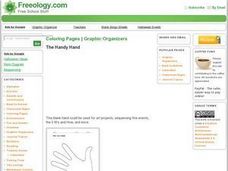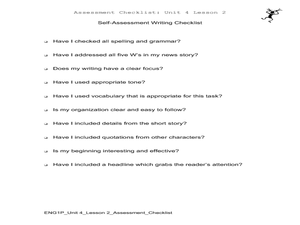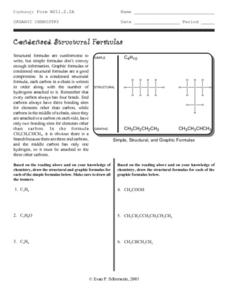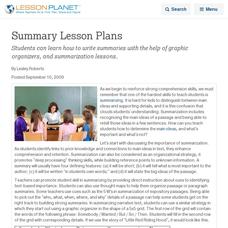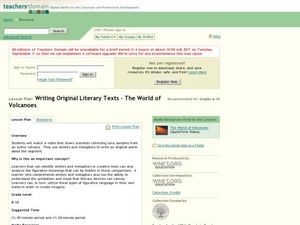Bainbridge Class
End of the Year Photo Writing Project
Close out the school year with a look back at a specific event. You provide individuals with photos of themselves, and each pupil fills out the graphic organizer here to prepare for writing a paragraph about the memory depicted in the...
Student Handouts
The Five W's and How
Here is a great graphic organizer for ensuring that young researchers and writers cover all their bases when brainstorming a topic by considering the five W's (who, what, where, when, and why) and how.
EngageNY
The Five W’s
Let's take the big W. Scholars analyze the model newspaper article Sandy wreaks havoc across Northeast; at
least 11 dead and look to answer who, what, when, where, and why. They work in groups of three to complete a Five W’s web...
Curated OER
The Five W's
In this graphic organizer worksheet, students answer the five w's in the provided spaces on the worksheet. There are five spaces on the worksheet to fill out. This is ideal to use as a reading comprehension tool.
Freeology
Questions: Graphic Organizer
What questions should your pupils ask when examining a topic? Cover who, what, where, when, why, and how with a graphic organizer. Kids will like that the graphic organizer is in the shape of a giant question mark!
Curated OER
5 W's Circle Graphic Organizer
In this language arts worksheet, students complete a 5 W's circle graphic organizer. They fill our the who, what, where, why, and when ovals around the center oval which is labeled for the topic.
Curated OER
Summarizing with James and the Giant Peach
Elementary readers in literature groups practice summarizing chapter-by-chapter with Roald Dahl's James and the Giant Peach. Focus on main idea, supporting details, and the 5 Ws. Unfortunately, a clever "peach" graphic organizer to which...
Curated OER
Organic Naming
For this organic compounds worksheet, learners complete a graphic organizer by writing the complete structural formula, line formula, and molecular formula for the given compounds.
Alabama Learning Exchange
Who, What, When, Where, Why, How?
Your youngsters are just starting to read texts and pull out important information. Use this graphic organizer with any text to help them practice identifying the who, what, when, where, why, and how of a text. Although the format of the...
Curated OER
Star 5 W's
In this graphic organizer worksheet, students fill in the graphic organizer with the 5 W's in each point of the star. Students complete 5 sections.
Curated OER
Build Mastery: Main Idea
Use a graphic organizer to get readers thinking about main ideas as they record the who, what, where, when, and why of a story. Consider modeling this process completely before kids do this independently. They fill in five boxes charting...
Curated OER
Give 'em a Hand
In this graphic organizer worksheet, students use the shape of the hand to find the who, what, where, when, and why for a text. Students write their answers in the fingers.
Curated OER
Who Am I?
Your budding journalists need to understand the five W's for writing a news story. They read a story, complete several graphic organizers to help them organize and write their article, and then use a self-assessment worksheet to edit and...
Curated OER
Summarizing - Squirrel Rehabilitation
Young scholars watch a video of how squirrels are rehabilitated back into nature and summarize it. They watch the video twice, paying close attention to detail. Before summarizing, they check their notes for important details and fill...
Curated OER
Five W's Chart
In this five W's chart worksheet, students fill in a graphic organizer with facts about the five W's: What, Who, Why, When and Where. Chart is for use with interactive white boards.
Curated OER
Organic Chemistry-Condensed Structural Formulas
In this structural formulas worksheet, students are given three condensed structural formulas and three non-condensed structural formulas. They draw the structural and graphic formulas for each compound.
Curated OER
Forming an Opinion with Organizational Elements - Cats, Yesterday and Today
In this age of information overload, it is often difficult for young people to know what they think about a topic. The graphic organizer, video, and activities included with this resource show middle schoolers how to use proven facts to...
Curated OER
How Are Polymers Utilized in Everyday Life?
Students investigate polymers and their uses in everyday life. In this polymers instructional activity, students are assigned one of the 10 areas of polymer science and they do research on their assigned area using the internet. Students...
Curated OER
Summary Lesson Plans
Students can learn how to write summaries with the help of graphic organizers, and summarization lessons.
Curated OER
Studying The Catcher in the Rye
What's the difference between being a phony and being a conformist? At what point does conforming to alleviate loneliness lead to insincerity? These are the questions at the heart of this unit plan that uses The Catcher in the Rye...
Curated OER
Writing Original Literary Texts - The World of Volcanoes
Students watch a video about an active volcano and use similes and metaphors to write an original poem. In this poetry and volcano instructional activity, students define similes and metaphors and brainstorm examples. Students watch a...
Curated OER
Condense, Combine, or Categorize New Information - Your Brain and Moral Decision-Making
Young scholars condense information and create a summary paragraph on a video segment. In this brain activity lesson plan, students watch a video that chronicles an experiment in how the brain responds when making moral...
Curated OER
Picture Story Board
In this story elements worksheet, students sketch 4 pictures to fill a story board graphic organizer. They draw the beginning of their story, two pictures for the middle, and one more for the ending.
Curated OER
Acid, Base, or Salt?
In this acids and bases worksheet, students read about the differences between acids and bases and then complete a table comparing the characteristics of both. Then students determine if the given statements describe an acid, base, or...











